
A working dog is a dog used to perform practical tasks, as opposed to pet or companion dogs.
Hog-dog rodeo or hog-dogging, is a spectator event that simulates wild or feral boar hunting with dogs. It requires specially trained and bred "hog dogs" that are used to bay and sometimes catch a hog or boar. In most cases, bay dogs psychologically control the pig and no physical contact occurs. In some cases, however, such as Uncle Earl's Hog Dog Trials, along with bay dog events, catch dog events have been included in the past. In these, specially bred and equipped dogs caught and held the hog by the ears before the animals were quickly separated by a person who hog-tied the pig.

A feral pig is a domestic pig which has gone feral, meaning it lives in the wild. The term feral pig has also been applied to wild boars, which can interbreed with domestic pigs. They are found mostly in the Americas and Australia. Razorback and wild hog are Americanisms applied to feral pigs or boar–pig hybrids.

The Karelian Bear Dog is a Finnish breed of dog. In its home country, it is seen by many as a national treasure. Karelian Bear Dogs will hunt a variety of animals. Its quick reflexes and fearless nature have made it very popular for hunting large game including brown bears, moose, and wild boar. It was the breed's ability to hunt bears that earned the breed its name. The Karelian Bear Dog is among the top 10 most common dog breeds in Finland.
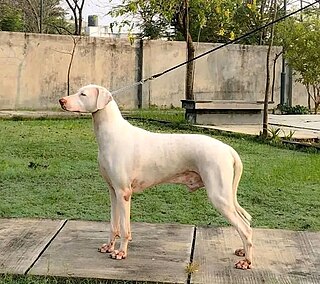
The Rajapalayam, also known as the Polygar Hound or Indian Ghost Hound, is a southern Indian dog breed. The breed is named after Rajapalayam, a town in the Virudhunagar, Tamil Nadu.
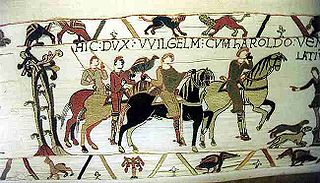
Royal hunting, also royal art of hunting, was a hunting practice of the aristocracy throughout the known world in the Middle Ages, from Europe to Far East. While humans hunted wild animals since time immemorial, and all classes engaged in hunting as an important source of food and at times the principal source of nutrition. The necessity of hunting was transformed into a stylized pastime of the aristocracy. More than a pastime, it was an important arena for social interaction, essential training for war, and a privilege and measurement of nobility. In Europe in the High Middle Ages the practice was widespread.

The Portuguese Podengo, also known as the Podengo Português or Portuguese Warren Hound, is a hound breed from Portugal. As a breed, the Podengo is divided into three size categories that are not interbred: small (Pequeno), medium (Médio) and large (Grande). Their coats are either short and 'smooth', or longer and 'wired'. The smooth coated variety is traditional, whereas the wire coated variety is an outcome of the assimilation of various other breeds during the 20th century. In general, the breed is healthy; the Pequeno (small) variety has an average lifespan of approximately 15–17 years.

Bulldogs are a type of dog that were traditionally used for the blood sports of baiting and dog fighting, but today are kept for other purposes, including companion dogs, guard dogs and catch dogs. Bulldogs are typically stocky, powerful, square-built animals with large, strong, brachycephalic-type muzzles. "Bull" is a reference that originated in England that refers to the sport of bull baiting, which was a national sport in England between the 13th and 18th century. It is believed bulldogs were developed during the 16th century in the Elizabethan era from the larger mastiffs, as smaller, more compact dogs were better suited for baiting.
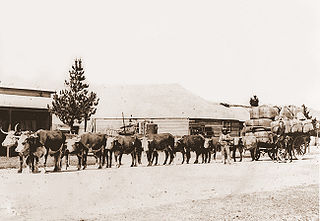
A working animal is an animal, usually domesticated, that is kept by humans and trained to perform tasks instead of being slaughtered to harvest animal products. Some are used for their physical strength or for transportation, while others are service animals trained to execute certain specialized tasks. They may also be used for milking or herding. Some, at the end of their working lives, may also be used for meat or leather.

A blood sport or bloodsport is a category of sport or entertainment that involves bloodshed. Common examples of the former include combat sports such as cockfighting and dog fighting, and some forms of hunting and fishing. Activities characterized as blood sports, but involving only human participants, include the ancient Roman gladiatorial games.
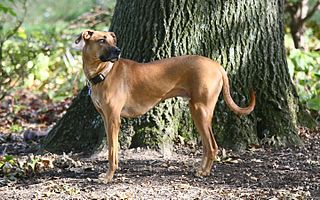
The Black Mouth Cur, also known as the Southern Cur, Southern Black Mouth Cur and the Yellow Black Mouth Cur, is a medium to large sized breed of cur-type dog from the United States. Originating in the south of the country, the breed is a popular hunting companion used to hunt a large variety of game.
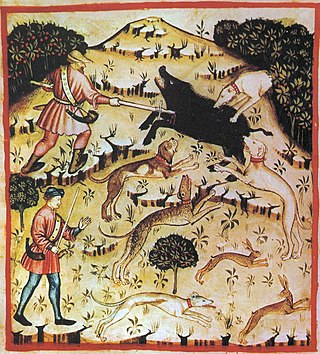
Boar hunting is the practice of hunting wild boar, feral pigs, warthogs, and peccaries. Boar hunting was historically a dangerous exercise due to the tusked animal's ambush tactics as well as its thick hide and dense bones rendering them difficult to kill with premodern weapons.
Uncle Earl's Hog Dog Trials is an annual Hog Dog Baying Event held in the third weekend of March in Winnfield, Winn Parish, Louisiana at the Winn Parish Fair Grounds involving boars and various breeds of bay dogs, including Catahoula Leopard Dogs, Blackmouth Cur, Blue Lacy, and others.
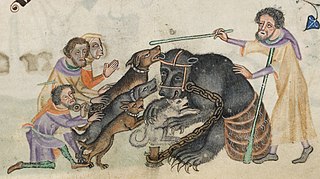
Bear-baiting is a blood sport in which a chained bear and one or more dogs are forced to fight one another. It may also involve pitting a bear against another animal. Until the 19th century, it was commonly performed in Great Britain, Sweden, India, Pakistan, and Mexico among others.

The Sabueso Español or Spanish Hound is a scenthound breed with its origin in the far north of Iberian Peninsula. This breed has been used in this mountainous region since hundreds of years ago for all kind of game: wild boar, hare, brown bear, wolf, red deer, fox, roe deer and chamois. It is an exclusive working breed, employed in hunting with firearms.

A bay dog is a dog that is specially trained to find, chase, and then bay, or howl, at a safe distance from large animals during a hunt, such as during a wild boar hunt.
A limer, or lymer, was a kind of dog, a scenthound, used on a leash in medieval times to find large game before it was hunted down by the pack. It was sometimes known as a lyam hound/dog or lime-hound, from the Middle English word lyam, meaning 'leash'. The French cognate limier has sometimes been used for the dogs in English as well. The type is not to be confused with the bandog, which was also a dog controlled by a leash, typically a chain, but was a watchdog or guard dog.

Human–canine bonding is the relationship between dogs and humans. This relationship can be traced back to at least 15,000 years ago, to the Bonn-Oberkassel dog, who was found buried alongside two humans. For centuries, dogs have been considered man's best friend. This is most evident in western countries, such as the United States, where over 48% of households have a pet dog.
Boar-baiting is a blood sport involving the baiting of wild boars against dogs.
The Erbi Txakur is a Spanish breed of scenthound. It originates in the provinces of Álava and Bizkaia in the Basque Autonomous Community in northern Spain. It is one of five Basque breeds of dog, the others being the Basque Shepherd Dog, the Pachón de Vitoria, the Villano de Las Encartaciones and the Villanuco de Las Encartaciones, and is one of fourteen animal breeds native to the Basque Country. It was traditionally used for hunting hare, but since the hare became scarce in the Basque country it is more frequently used to hunt wild boar, roe deer or occasionally foxes.
















